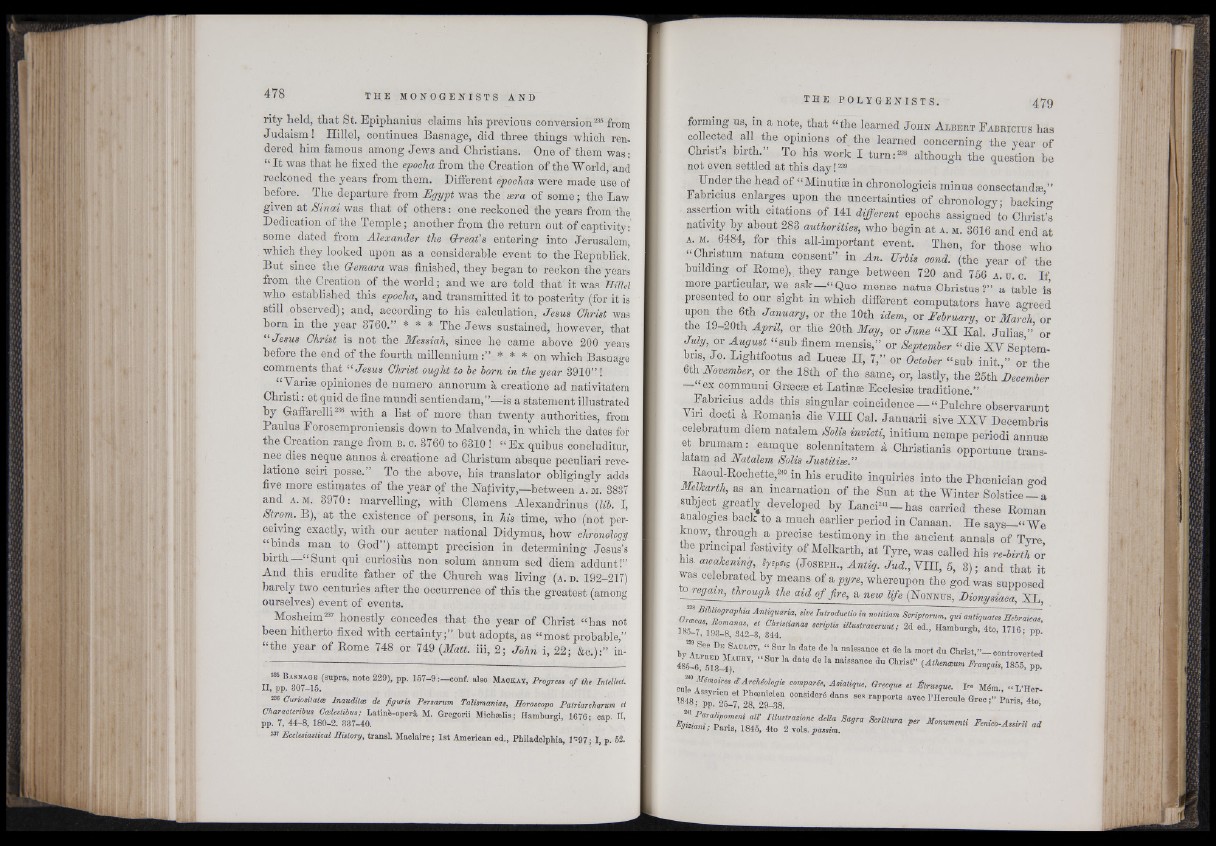
rity held, that St. Epiphanius claims his previous conversion235 from
Judaism! Hillel, continues Basnage, did three things which rendered
him famous among Jews and Christians. One of them was:
“ It was that he fixed the epocha from the Creation of the World, and
reckoned the years from them. Different epochas were made use of
before. The departure from Egypt was the. sera of some; the Law
given at Sinai was that of others: one reckoned the years from the
Dedication of the Temple; another from the return out of captivity:
some dated from Alexander the Great’s entering into Jerusalem,
which they looked upon as a considerable event to the Republick!
But since the Gemara was finished, they began to reckon the years
from the Creation of the world ; and we are told that it was Hillel
who established this epocha, and transmitted it to posterity (for it is
still observed); and, according to his calculation, Jesus Christ was
bom in the year 8760.” * * * The Jews sustained, however, that
“ Jesus Christ is not the Messiah, since he came above 200 years
before the end of the fourth m ille n n ium * * * on which Basnage
comments that “ Jesus Christ ought to be born in the year 3910” !
“ Varise opiniones de numero annorum 4 creatione ad nativitatem
Christi: et quid de fine mundi sentiendam,”—is a statement illustrated
by Gaffarelli236 with a list of more than twenty authorities, from
Paulus Forosemproniensis down to Malvenda, in which the dates for
the Creation range from b . c. 3760 to 6310! “ Ex quibus concluditur,
nee dies neque annos 4 creatione ad Christum absque peculiari reve-
latione sciri posse.” To the above, his translator obligingly adds
five more estimates of the year of the Nativity,— between a. m . 3837
and a . m. 3970: marvelling, with Clemens Alexandrinus (lib. I,
Strom. B), at the existence of persons, in his time, who (not perceiving
exactly, with our acuter national Didymus, how chronology
“ binds man to God’’) attempt precision in determining Jesus’s
birth “ Sunt qui curiosius non solum annum sed diem addunt!’-’
And this erudite father of the Church was living (a . d . 192-217)
barely two centuries after the occurrence of this the greatest (among
ourselves) event of events.
Mosheim237 honestly concedes that the year of Christ “has not
been hitherto fixed with certainty;” but adopts, as “most probable,”
“the year of Rome 748 or 749 {Matt, iii, 2; John i, 22; &c.):” in335
B a s n a g e (supra, note 229), pp. 157-9:—conf. also M a o k a y , Progress of the Intellect.
II, pp. 307-15.
236 Gun™tat<z lnauditoe de figuris Persarum Talismanias, Horoscopo Patriarcharum et
Characteribus Ceeleslibus; Latinh-opera M. Gregorii Miehrelis; Hamburgi 1676- cat) II,
pp. 7, 44-8, 180-2. 337-40. S ’ ’ ,’
*8 Ecclesiastical History, transl. Maolaire; 1st American ed., Philadelphia, 1?97; I, p. 62.
forming us in a note, that “the learned J ohn A l be r t F a b r ic iu s has
collected all the opinions of the learned concerning the year of
Christ’s birth,” To his work I turn:-3 although the question be
not even settled at this day!239
Under the head of “Minutiae in chronologicis minus consectandm,”
Fabricius enlarges upon the uncertainties of chronology; backing
assertion with citations of 141 different epochs assigned to Christ?
nativity by about 283 authorities, who begin at a . m. 3616 and end at
a. m 6484, for this all-important event. Then, for those who
Christum natum consent” in An. Urbis cond. (the year of the
building of Rome), they range between 720 and 756 a . it. c. If
more particular, we ask—“ Quo mense natus Christus ?” a table is
presented to our sight in which different computators have agreed
OT tHe 10th idem> or February, or March, or
the 19-20th April, or the 20th May, or June “XI Xal. Julias ” or
July, or August “ sub finem mensis,” or September “ die XV Septemb
e r© . Lightfootus ad Lucrn II, 7,” or October “sub init.,” or the
6th November, or the 18th of the same, or, lastly, the 25th December
ex eommuni Graecse et Latinse Eeclesise traditione.”
Fabricius adds this singular coincidence — “ Pulchre observarunt
Vm docti 4 Romanis die VIII Cal. Januarii sive XXV Decembris
celebratum diem natalem Solis invicti, initium nempe periodi annum
I I eamque solennitatem 4 Christianis opportune trans-
latam ad Natalem Solis Justitiee.”
Raoul-Rochette,240 in his erudite inquiries into the Phoenician god
Mellcarth, as an incarnation of the Sun at the Winter Solstice — a
subject greatfr developed by L a n c i- -h a s carried these Roman
analogies back to a much earlier period in Canaan. He says—“We
now, through a precise testimony in the ancient annals of Tvre
the principal festivity of Melkarth, at Tyre, was called his re-birth or
5is. awakening ( J ose ph ., Antiq. Jud., VIH, 5, 3); and that it
s celebrated, by means of a pyre, whereupon the god was supposed
^ r egain, through the aid of fire, a new life (Nqnnps. Dionysiaca, XL,
gZcTpIZ^ A V *InMUeli0 £ n0Htiam qUi mtiquata C a i c o s ,
185-7, 193-8^842-3, 3 « ¡ ¡ l l j iUmtTaVerUnt; 2d ed” Hamburgh, 4to, 1716; pp.
b v ^ f r DE, TSAULCT- “ Snr ,a date de ,a naissance et de la mort du Christ,”-controverted
485-6; 518_4ynEY’ “ SUr " ^ ^ U DaiSSan0° du Christ” F r a n k s , 1855, pp.
* * * * * * * * * * * comp are Asiaiique, Grecque et titrmque. M<Sm - L ’Her
WtfvTllX “ - S COnSiderf daDS eeS raPPOrtS 8Ve° rHer0Ule Greo’-” Pari«. 4*«. «¡stsis rrr'¿a*- "pp Ipfcs -